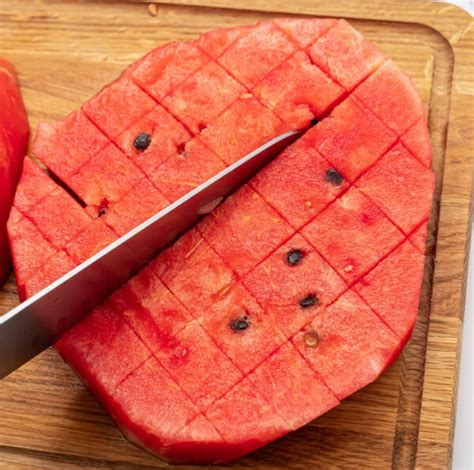
A food editor has revealed a simple and speedy watermelon cutting technique that promises to streamline summer snacking. Instead of struggling with cumbersome wedges, this method involves creating easily manageable sticks, perfect for serving and enjoying the juicy fruit.
The traditional method of slicing a watermelon can be a messy and time-consuming affair, often resulting in uneven pieces and sticky hands. However, according to Justin Sullivan, a food editor, there’s a better way. This innovative cutting hack transforms the watermelon into a platter of convenient sticks, eliminating much of the hassle typically associated with preparing the fruit. The technique not only simplifies the process but also enhances the eating experience.
Sullivan demonstrated the method in a now widely circulated video. He starts by halving the watermelon. Then, he places each half cut-side down on a cutting board and slices it into one-inch thick planks. Next, he rotates the planks and cuts them again into one-inch thick sticks. The result is a collection of perfectly portioned watermelon sticks that are easy to grab and enjoy, making it an ideal solution for picnics, barbecues, or a quick and refreshing snack.
“This is the best way to cut a watermelon,” Sullivan stated, highlighting the method’s efficiency and convenience. The technique has garnered significant attention online, with many users praising its simplicity and effectiveness.
Beyond its ease, the watermelon stick method also addresses several practical concerns. The uniform shape of the sticks makes them ideal for serving at gatherings, reducing the mess and allowing guests to easily handle the fruit. The sticks also fit conveniently into lunchboxes or containers, making them a great option for on-the-go snacking. Furthermore, this method maximizes the edible portion of the watermelon, minimizing waste and ensuring that you get the most out of your fruit.
The beauty of this hack lies in its simplicity. All you need is a sharp knife and a cutting board. There are no specialized tools or complicated steps involved. The technique can be easily mastered by anyone, regardless of their culinary experience. By adopting this method, you can transform the way you prepare and enjoy watermelon, turning it from a chore into a pleasure.
Watermelon is more than just a delicious summer treat; it’s also packed with nutrients and health benefits. The fruit is rich in vitamins A and C, as well as antioxidants like lycopene. It is also a good source of hydration, due to its high water content. Incorporating watermelon into your diet can contribute to overall health and well-being, especially during the hot summer months.
The watermelon stick cutting hack is a game-changer for anyone who loves this refreshing fruit. By simplifying the preparation process, this method makes it easier to enjoy watermelon anytime, anywhere. Whether you’re hosting a summer barbecue, packing a lunch for work, or simply craving a healthy snack, this technique is sure to become your go-to for cutting watermelon.
Detailed Breakdown of the Watermelon Cutting Hack
The appeal of Justin Sullivan’s watermelon cutting hack lies not only in its simplicity but also in its effectiveness. To fully appreciate and master this technique, a detailed breakdown of each step is essential. This comprehensive guide will ensure that you can replicate the method flawlessly, transforming your watermelon preparation from a cumbersome task into a seamless experience.
Step 1: Preparing the Watermelon
The first step involves selecting a ripe watermelon. Look for a watermelon that is firm, heavy for its size, and has a dull rind. A yellow spot, where the watermelon rested on the ground, is also a good indicator of ripeness. Once you have chosen your watermelon, wash it thoroughly under cold running water to remove any dirt or debris. This is a crucial step for food safety, ensuring that no contaminants are transferred to the flesh of the watermelon during cutting.
Step 2: Halving the Watermelon
Place the watermelon on a large, sturdy cutting board. Using a sharp, long knife, carefully cut the watermelon in half lengthwise. Ensure that the knife is sharp enough to slice through the tough rind without slipping. A serrated knife can be particularly effective for this step. Apply even pressure as you cut, maintaining a steady and controlled motion. Once the watermelon is halved, you will have two large, semi-circular pieces ready for the next step.
Step 3: Creating the Planks
Take one of the watermelon halves and place it cut-side down on the cutting board. This provides a stable base for slicing. Now, begin slicing the watermelon into planks that are approximately one inch thick. The thickness of the planks can be adjusted to your preference, but one inch is generally considered to be an ideal size for creating manageable sticks.
As you slice, maintain a consistent thickness to ensure that the resulting sticks are uniform in size and shape. This not only enhances the aesthetic appeal of the final product but also makes them easier to handle and eat. Repeat this process with the other watermelon half until you have a collection of evenly sliced planks.
Step 4: Forming the Sticks
Once you have your watermelon planks, rotate them 90 degrees so that they are perpendicular to the direction of your previous cuts. Now, slice the planks again into one-inch thick sticks. This process will create a grid-like pattern, transforming the planks into a collection of perfectly portioned watermelon sticks.
As with the plank-cutting step, consistency is key. Aim for uniform thickness to ensure that the sticks are easy to handle and visually appealing. Take your time and maintain a steady hand to achieve the best results.
Step 5: Serving and Enjoying
Once you have cut all of the watermelon into sticks, you can arrange them on a platter for serving. The sticks can be presented in a variety of ways, depending on your preferences. You can arrange them in a circular pattern, stack them in a pyramid shape, or simply scatter them artfully across the platter.
The watermelon sticks are now ready to be enjoyed. Their convenient shape makes them easy to grab and eat, whether you’re at a picnic, barbecue, or simply relaxing at home. The sticks can also be dipped in yogurt, sprinkled with lime juice, or paired with other fruits for a more elaborate snack.
Tips and Tricks for Perfect Watermelon Sticks
While the watermelon stick cutting hack is relatively straightforward, there are a few tips and tricks that can help you achieve even better results. These suggestions will enhance your watermelon-cutting experience and ensure that you consistently produce perfect watermelon sticks.
- Use a Sharp Knife: A sharp knife is essential for this cutting technique. A dull knife can slip and slide, making it difficult to cut through the tough rind of the watermelon. Invest in a high-quality knife and keep it sharp to ensure clean, precise cuts.
- Choose a Sturdy Cutting Board: A stable cutting board is crucial for safety and efficiency. Look for a large cutting board that won’t slip or slide while you’re cutting. A wooden or plastic cutting board with non-slip feet is a good choice.
- Maintain a Consistent Thickness: Consistency is key to creating uniform watermelon sticks. Take your time and aim for even slices when cutting the planks and the sticks. This will not only enhance the aesthetic appeal of the final product but also make them easier to handle and eat.
- Chill the Watermelon: Chilling the watermelon before cutting can make it easier to handle. The cold temperature will firm up the flesh, making it less slippery and easier to slice. Place the watermelon in the refrigerator for at least an hour before cutting.
- Consider Seedless Watermelon: If you prefer a seedless watermelon, opt for a variety that is specifically labeled as such. Seedless watermelons are generally easier to cut and eat, as you don’t have to worry about removing the seeds.
- Experiment with Flavors: Once you have mastered the watermelon stick cutting hack, you can experiment with different flavors and toppings. Try sprinkling the sticks with lime juice, chili powder, or a drizzle of honey. You can also dip them in yogurt, cream cheese, or a homemade fruit dip.
- Store Properly: If you’re not planning to eat all of the watermelon sticks immediately, store them in an airtight container in the refrigerator. They will stay fresh for several days, making them a convenient snack to have on hand.
The Science Behind Watermelon’s Refreshing Qualities
Watermelon is not only delicious but also incredibly refreshing, especially during the hot summer months. Its refreshing qualities are due to a combination of factors, including its high water content, electrolyte balance, and cooling properties. Understanding the science behind watermelon’s refreshing qualities can help you appreciate this fruit even more.
- High Water Content: Watermelon is approximately 92% water, making it one of the most hydrating fruits available. This high water content helps to replenish fluids lost through sweat, keeping you hydrated and energized.
- Electrolyte Balance: Watermelon contains electrolytes such as potassium and magnesium, which are essential for maintaining fluid balance in the body. Electrolytes are lost through sweat, and replenishing them is crucial for preventing dehydration and muscle cramps.
- Cooling Properties: Watermelon has a natural cooling effect on the body. This is due to its high water content and its ability to lower body temperature. Eating watermelon on a hot day can help you feel cooler and more comfortable.
- Nutrient-Rich: Watermelon is also rich in vitamins, minerals, and antioxidants. It contains vitamins A and C, as well as lycopene, a powerful antioxidant that has been linked to a reduced risk of certain cancers.
- Digestive Benefits: Watermelon is easy to digest and contains fiber, which can help to promote healthy digestion. Fiber helps to keep the digestive system moving smoothly, preventing constipation and other digestive issues.
The Culinary Versatility of Watermelon: Beyond Simple Slices
While the watermelon stick cutting hack is a great way to enjoy this fruit in its simplest form, watermelon is also incredibly versatile and can be used in a variety of culinary applications. From salads and salsas to smoothies and desserts, watermelon can add a refreshing and unexpected twist to your favorite dishes.
- Watermelon Salad: Watermelon salad is a classic summer dish that combines the sweetness of watermelon with the savory flavors of feta cheese, mint, and balsamic vinegar. The combination of flavors and textures is both refreshing and satisfying.
- Watermelon Salsa: Watermelon salsa is a fun and flavorful twist on traditional salsa. It combines diced watermelon with red onion, cilantro, jalapeño, and lime juice for a sweet, spicy, and refreshing condiment.
- Watermelon Smoothie: Watermelon smoothie is a healthy and refreshing way to start your day. It combines watermelon with other fruits, such as berries and bananas, along with yogurt or milk for a creamy and nutritious beverage.
- Grilled Watermelon: Grilling watermelon caramelizes the natural sugars, creating a smoky and slightly sweet flavor. Grilled watermelon can be served as a side dish or used as a topping for salads and sandwiches.
- Watermelon Gazpacho: Watermelon gazpacho is a refreshing and chilled soup that is perfect for hot summer days. It combines watermelon with tomatoes, cucumbers, bell peppers, and other vegetables for a light and flavorful meal.
- Watermelon Sorbet: Watermelon sorbet is a refreshing and healthy dessert that is easy to make at home. It combines pureed watermelon with sugar and lemon juice, then freezes it for a light and refreshing treat.
- Watermelon Cocktails: Watermelon can be used to create a variety of refreshing cocktails, such as watermelon margaritas, watermelon mojitos, and watermelon sangria. The sweetness of the watermelon pairs well with spirits and other mixers.
- Pickled Watermelon Rind: Don’t throw away the watermelon rind! It can be pickled and used as a tangy and crunchy condiment. Pickled watermelon rind is a unique and flavorful addition to sandwiches, salads, and charcuterie boards.
Watermelon and Its Cultural Significance Across the Globe
Watermelon is not just a delicious and refreshing fruit; it also holds cultural significance in many parts of the world. Its association with summer, abundance, and celebration has made it a symbol of joy and togetherness.
- United States: In the United States, watermelon is often associated with summer barbecues, picnics, and Fourth of July celebrations. It is a symbol of American summertime and is often featured in patriotic decorations and festivities.
- China: In China, watermelon is a symbol of prosperity and good fortune. It is often given as a gift during the Lunar New Year and other special occasions. The red color of the watermelon flesh is considered to be auspicious.
- Japan: In Japan, watermelon is a popular summer treat and is often enjoyed at festivals and outdoor events. Seedless watermelons are particularly prized in Japan, and specialized techniques are used to grow them.
- Middle East: In the Middle East, watermelon is a staple food during the hot summer months. It is often eaten as a refreshing snack or used in salads and other dishes. Watermelon juice is also a popular beverage.
- Africa: In many parts of Africa, watermelon is an important source of hydration and nutrients, especially during the dry season. It is often grown in community gardens and shared among families and neighbors.
- Russia: In Russia, watermelon is a popular summer fruit and is often sold at roadside stands and markets. It is enjoyed as a refreshing snack or used in salads and desserts. Watermelon is also used to make a traditional Russian drink called “kvas.”
- Brazil: In Brazil, watermelon is a common fruit and is often eaten fresh or used in juices and smoothies. It is also used to make a traditional Brazilian dessert called “melancia caramelizada” (caramelized watermelon).
Environmental Considerations: Choosing Sustainable Watermelon
As consumers become increasingly aware of the environmental impact of their food choices, it is important to consider the sustainability of the watermelons we purchase. Choosing sustainable watermelon can help to reduce our carbon footprint and support environmentally friendly farming practices.
- Local Sourcing: Buying watermelon from local farmers reduces the environmental impact of transportation. Locally grown watermelons travel shorter distances, reducing fuel consumption and greenhouse gas emissions.
- Organic Farming: Organic watermelon farming practices avoid the use of synthetic pesticides and fertilizers, which can pollute soil and water. Organic farming also promotes biodiversity and soil health.
- Water Conservation: Watermelon farmers can use water-efficient irrigation techniques, such as drip irrigation, to conserve water resources. Drip irrigation delivers water directly to the roots of the plants, minimizing water loss through evaporation.
- Waste Reduction: Reducing food waste is another important aspect of sustainability. Properly storing watermelon and using all parts of the fruit, including the rind, can help to minimize waste.
- Packaging: Choosing watermelon that is minimally packaged can also reduce environmental impact. Avoid watermelons that are individually wrapped in plastic or packaged in excessive amounts of cardboard.
- Fair Trade: Supporting fair trade watermelon farmers ensures that they receive fair prices for their products and that workers are treated ethically. Look for fair trade certifications when purchasing watermelon.
By making informed choices about the watermelons we buy, we can support sustainable farming practices and reduce our environmental impact.
Frequently Asked Questions (FAQ)
-
What is the quickest way to cut a watermelon according to the food editor? The quickest way involves halving the watermelon, placing each half cut-side down, slicing into one-inch thick planks, rotating the planks, and slicing again into one-inch thick sticks. This creates easily manageable and portioned watermelon sticks.
-
What are the benefits of cutting watermelon into sticks instead of traditional wedges? The watermelon stick method simplifies the process, reduces mess, creates uniform portions perfect for serving, and makes the fruit easy to handle for both adults and children. They are also ideal for packing in lunchboxes or containers for on-the-go snacking.
-
What type of knife is recommended for this watermelon cutting hack? A sharp, long knife is recommended. A serrated knife can be particularly effective for cutting through the tough rind of the watermelon without slipping. Maintaining a sharp blade is crucial for safety and efficiency.
-
How should I store the watermelon sticks if I don’t eat them all at once? Store the watermelon sticks in an airtight container in the refrigerator. They will stay fresh for several days, making them a convenient snack to have on hand. Proper storage prevents the watermelon from drying out and absorbing odors from other foods in the refrigerator.
-
Besides eating them plain, what are some other ways I can use watermelon sticks? Watermelon sticks can be used in various ways, such as dipping them in yogurt, sprinkling them with lime juice or chili powder, adding them to salads, or blending them into smoothies. Their versatility makes them a great addition to many dishes and snacks.









